Content for TS 38.323 Word version: 18.3.0
4 General
4.1 Introduction
4.2 Architecture
4.2.1 PDCP structure
4.2.2 PDCP entities
4.3 Services
4.3.1 Services provided to upper layers
4.3.2 Services expected from lower layers
4.4 Functions
...
...
4 General p. 10
4.1 Introduction p. 10
The present document describes the functionality of the PDCP.
4.2 Architecture p. 10
4.2.1 PDCP structure p. 10
Figure 4.2.1-1 represents one possible structure for the PDCP sublayer for non-relay scenario. Figure 4.2.1-2 represents one possible structure for the PDCP sublayer used in L2 U2N relay case, L2 U2U relay case, and for the indirect path in the case of multi-path with SL indirect path. Figure 4.2.1-3 represents one possible structure for the PDCP sublayer used for the indirect path in the case of multi-path with N3C indirect path. These structures should not restrict implementation. The figures are based on the radio interface protocol architecture defined in TS 38.300.
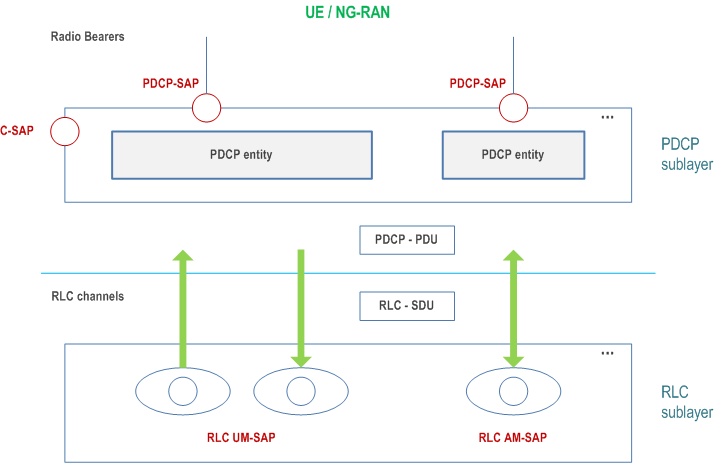
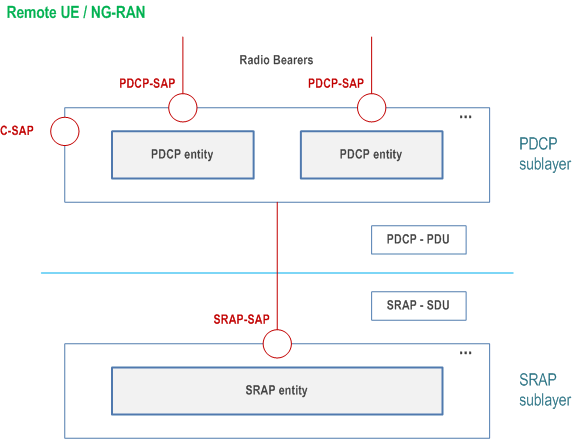
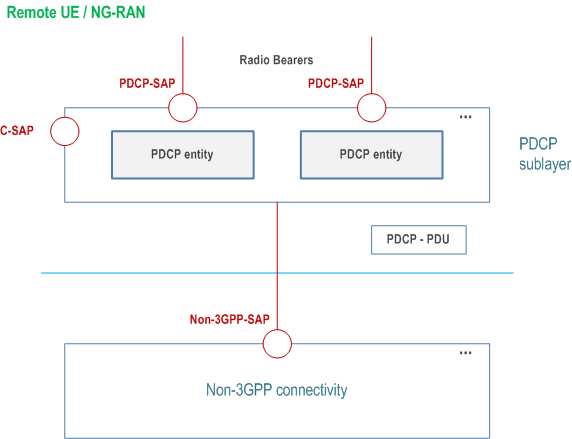
The PDCP sublayer is configured by upper layers TS 38.331. The PDCP sublayer is used for RBs mapped on DCCH, DTCH, MTCH, SCCH, and STCH type of logical channels. The PDCP sublayer is not used for any other type of logical channels.
Each RB (except for SRB0 for Uu interface) is associated with one PDCP entity. Each PDCP entity is associated with one, two, three, four, six, or eight RLC entities depending on the RB characteristic (e.g. uni-directional/bi-directional or split/non-split) or RLC mode:
- For split bearers, each PDCP entity is associated with two UM RLC entities (for same direction), four UM RLC entities (two for each direction), or two AM RLC entities;
- For RBs configured with PDCP duplication, each PDCP entity is associated with N UM RLC entities (for same direction), 2 × N UM RLC entities (N for each direction), or N AM RLC entities, where 2 ≤ N ≤ 4;
- For DAPS bearers, each PDCP entity is associated with two UM RLC entities (for same direction, one for source and one for target cell), four UM RLC entities (two for each direction on source cell and target cell), or two AM RLC entities (one for source cell and one for target cell);
- For UM MRBs, each PDCP entity is associated with one UM RLC entity (for MTCH or for downlink DTCH), two UM RLC entities (one for MTCH and one for downlink DTCH, or one for downlink DTCH and one for uplink DTCH), or three UM RLC entities (one for MTCH, one for downlink DTCH, and one for uplink DTCH);
- For AM MRBs, each PDCP entity is associated with one AM RLC entity (for downlink DTCH and uplink DTCH), or one UM RLC entity (for MTCH) and one AM RLC entity (for downlink DTCH and uplink DTCH);
- For MP split bearers with SL indirect path, each PDCP entity is associated with one or more Uu RLC entities and one SRAP entity;
- For MP split bearers with N3C indirect path, each PDCP entity is associated with one or more Uu RLC entities and the N3C;
- Otherwise, each PDCP entity is associated with one UM RLC entity, two UM RLC entities (one for each direction), or one AM RLC entity.
4.2.2 PDCP entities p. 13
The PDCP entities are located in the PDCP sublayer. Several PDCP entities may be defined for a UE. Each PDCP entity is carrying the data of one radio bearer. A PDCP entity is associated either to the control plane or the user plane depending on which radio bearer it is carrying data for.
Figure 4.2.2-1 represents the functional view of the PDCP entity for the PDCP sublayer; it should not restrict implementation. The Figure is based on the radio interface protocol architecture defined in TS 38.300.
For split bearers, MP split bearers, and DAPS bearers, routing is performed in the transmitting PDCP entity.
A PDCP entity associated with DRB can be configured by upper layers TS 38.331 to use header compression or uplink data compression (UDC). A PDCP entity associated with MRB can be configured by upper layers TS 38.331 to use header compression. In this version of the specification, the robust header compression protocol (ROHC), the Ethernet header compression protocol (EHC) and UDC are supported. Each header compression protocol is independently configured for a DRB/MRB.
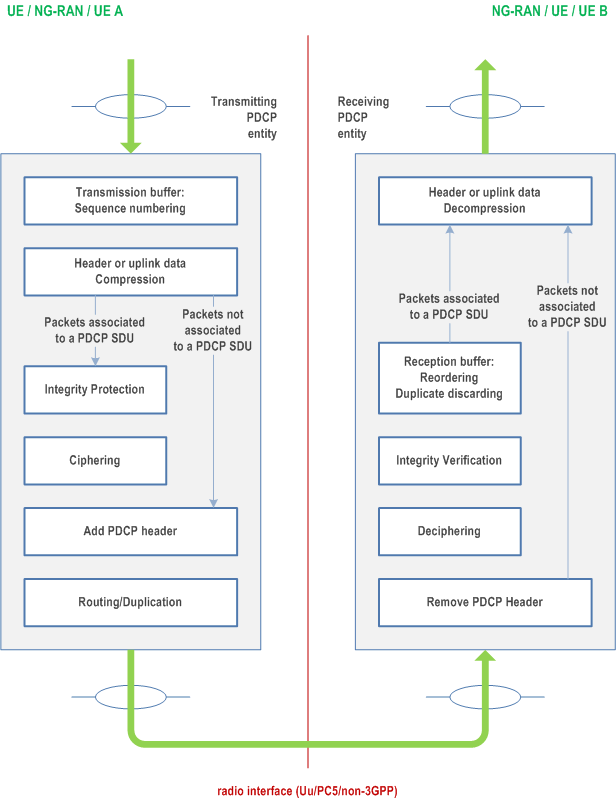
Figure 4.2.2-2 represents the functional view of the PDCP entity associated with the DAPS bearer for the PDCP sublayer; it should not restrict implementation. The Figure is based on the radio interface protocol architecture defined in TS 38.300.
For DAPS bearers, the PDCP entity is configured with two sets of security functions and keys and two sets of header compression protocols.
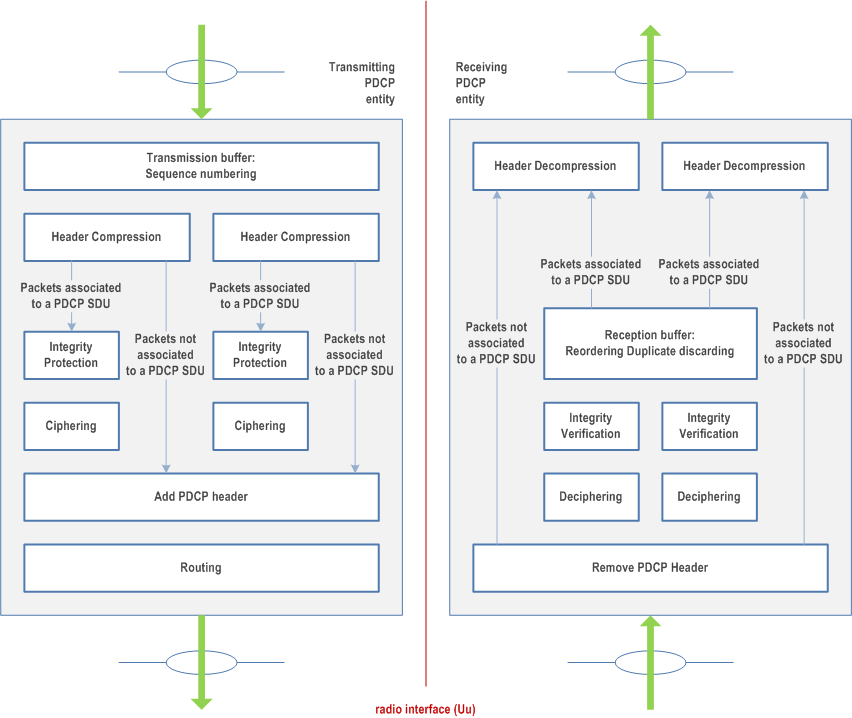
4.3 Services p. 14
4.3.1 Services provided to upper layers p. 14
The PDCP layer provides its services to the RRC or SDAP layers. The following services are provided by PDCP to upper layers:
- transfer of user plane data;
- transfer of control plane data;
- header compression;
- uplink data compression;
- ciphering;
- integrity protection.
4.3.2 Services expected from lower layers p. 14
A PDCP entity expects the following services from lower layers per RLC entity (for a detailed description see TS 38.322):
- acknowledged data transfer service, including indication of successful delivery of PDCP PDUs;
- unacknowledged data transfer service.
- data transfer.
- data transfer.
4.4 Functions p. 15
The PDCP layer supports the following functions:
- transfer of data (user plane or control plane);
- maintenance of PDCP SNs;
- header compression and decompression using the ROHC protocol;
- header compression and decompression using the EHC protocol;
- uplink data compression and decompression using the UDC protocol;
- ciphering and deciphering;
- integrity protection and integrity verification;
- timer based SDU discard;
- PDU Set discard;
- PSI based SDU discard;
- for split bearers and DAPS bearer, routing;
- duplication;
- reordering and in-order delivery;
- out-of-order delivery;
- duplicate discarding.